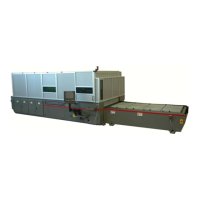3-8
EM-573 (N-04-18)
The type and style of eye protection to use should be worked out with the supplier of shop eye protection.
Staring at the cutting plume is not necessary or advisable. The light energy being sent out by the cutting process
is a mixture of many wavelengths. Besides the reection of the laser beam there is the scattered radiation of the
cutting process. The plume emits visible light and ultraviolet light.
It is the users responsibility to establish and enforce an eye protection program.
SKIN HAZARDS
Laser radiation striking the skin is reected, absorbed, and transmitted. The percentage of each depends upon
the characteristics of the skin at the wavelengths of concern.
Effects on the skin from absorbed radiation may vary from mild redness to blistering and/or charring, depending
upon the total energy absorbed and the rate at which it is absorbed. Unnecessary exposure of the skin to laser
radiation should be avoided regardless of the level of radiant energy.
The CINCINNATI Laser System - Fiber Laser has been tested and found to have no detectable x-ray emissions
and related hazards.
In general, the hazards presented by the CINCINNATI Laser System - Fiber Laser will be severe burns,
lacerations, and possible amputation if members of the body are exposed to the direct beam or reected beams
of high energy.
The design of the Laser System provides engineered protection from these hazards for personnel while properly
using this equipment. This basic design should not be altered or modied in any manner.
NOMINAL HAZARD ZONES
Safety standards dene a laser’s Nominal Hazard Zone (NHZ) as “the space within which the level of the
direct, reected, or scattered radiation during operation exceeds the applicable Maximum Permissible Exposure
(MPE)”.
When considering a CINCINNATI Laser System - Fiber Laser, the radiation hazard is the laser beam which is
strong enough to cause severe burns to the surface of the eye or skin if a worker is directly in its path or hit by
the beam as it is reected off machine or piece part surfaces.
The NHZ is the space in all directions away from the beam where the heat from the beam is strong enough to
cause injury. The NHZ can be calculated using the formulas and charts contained in the ANSI Z136.1 Safety
Standard and used in this manual.
During piece part cutting, the beam is fully contained within the ber optic cable and exits only at the cutting
head. Figure 3-4 shows the usual path of the laser beam. At the cutting head, the lens focuses the beam
downward to a spot as the beam exits to process material.
BEAM EXPOSURE CATEGORIES
There are three categories of potential laser beam exposures on any laser cutting system:
• Intra-beam Exposure
• Specular Reection Beam Exposure
• Diffuse Reection Beam Exposure

